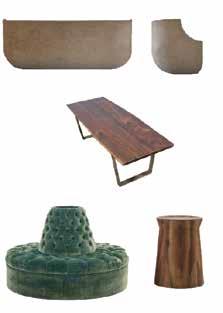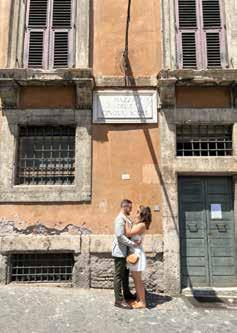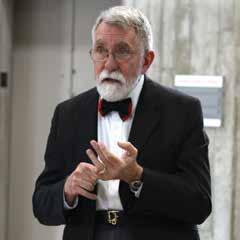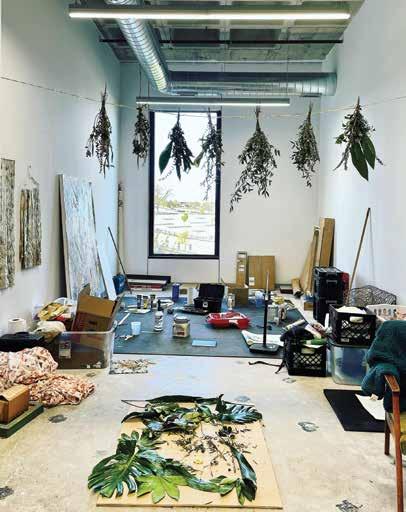




























































Trent’anni.
That’s Italian for “30 years,” but for the Iowa State University College of Design Rome Program, the phrase signifies change, resilience and success.
For three decades, the Rome Program has provided students a transformative study abroad experience. The program’s pearl anniversary, albeit one interrupted by COVID, will soon be celebrated with a series of events that showcase its enduring value and impact.
“Students transform during the semester. They become more independent and confident and discover new skills,” said Pia Schneider, who joined the Rome Program as the first local design instructor in 2000 and became resident director in 2007. “Some make lifelong friendships with students from other majors, or even find their partners for life.”
Home to iconic examples of historical and contemporary art and design,
Rome is uniquely suited to enrich the lives of students from a range of disciplines.

“They’re learning so much and absorbing so much,” said Sarah Kyle, chair of the Department of Art and Visual Culture, which sends students majoring in art and design and integrated studio arts to Rome each fall. “Their color palettes change. They come back much more in love with color.”
William Conway joined the Iowa State architecture faculty in 1990. At that time, the department had a program that took students on tours of several European countries. Conway, having lived in Rome as a Fulbright Scholar, suggested another approach: a semester in a specific location. And, thus, the Rome Program was born.
Conway took 15 architecture students to Rome for the spring semester of 1991. Romolo Martemucci, currently
president of the Pantheon Institute in Rome and then a professor of architecture at Pennsylvania State University, joined the group with 15 students of his own.
The students were “real trailblazers,” said Conway, who later joined the University of Minnesota College of Design and retired as a professor emeritus of architecture.

“I give them all the credit for their incredible resilience and inventiveness. Iowa State students greet the world in a friendly, engaging manner. The work they did was absolutely stunning.”
Will Downing (BArch 1993 Architecture) was among those first 15 intrepid ISU students.
“Foreign travel has always been a draw for me, especially from my love of world history and urban design. I’d taken a fantastic architecture history class at ISU that made me even more
interested in seeing these places and buildings for myself,” said Downing, now an architect with RDG Planning and Design in Iowa City.
“I don’t think I could really understand the role of architecture without seeing ways of life outside of my own culture.”
The Rome Program has grown gradually from 15 architecture students that first semester to more than 100 students majoring in architecture, art and design, graphic design, interior design, integrated studio arts and landscape architecture who now spend a semester in Rome each year.

Community and regional planning students studied in Rome in summer 2004 and returned in 2022. The college’s newest major, industrial design, was approved in 2010, and industrial design students traveled to Rome during the summers of 2012, 2013 and 2014. That department is expected to join the semester-long program in fall 2023.
“This is a big step forward for the Rome Program to incorporate all of the college’s majors,” said Jen Hogan, College of Design director of international programs. “The goal is for Rome to feel like home for the Design family.”
Prior to 1999, the program shared studio and office space with other American
universities, including Penn State and the University of Washington. The college then leased studios and lecture rooms in the Palazzo della Prelatura Spinola.
Since 2005, the Rome Program has been located in the historic center of the city near the Tiber River in the Palazzo CenciBolognetti (see inset).

The move provided more stable headquarters and an attractive studio space in a historic 16th-century structure built on the remains of a medieval castle. Known as the ISU Rome Center, it makes for a compelling learning environment – albeit one that required updating to provide internet access and accommodate co-curricular activities like a cooking class.
For much of the program’s history, Iowa State faculty from campus taught courses in Rome, enhanced through guest lectures and workshops offered by Rome-based instructors. Local faculty now exclusively teach the program. Art and design studios are complemented by classes in

art history, Italian language and cuisine to help immerse students in the culture.
“The model for study abroad was a branch campus where faculty from the home institution traveled to teach and provide students with the same experience in a different location,” Hogan said.
“The emphasis has shifted to a truly immersive educational and cultural experience with equal academic rigor and greater flexibility,” she said. “We also bring our Rome instructors to Ames to teach and interact with students and faculty, which builds connections and integrates the Rome Program more fully into the College of Design community.”
Architect Simone Capra coordinates teaching activities with colleagues each spring, augmented with lectures by contemporary architects and designers and field trips within Rome and Italy.
“It is important to us that every student can follow her or his own approach supported by our different perspectives and sensitivities to the space,” said Capra, a Rome Program faculty member since 2016.
“Every year there is a moment when student projects evolve from a very functionalist layout into something more complex, when their work involves the topography of the site, looks at the social conditions of the area and is respectful of the historical traces that basically represent the diversity of the cities of the world and their culture.”
Silvia Aloisio, an architect-interior designer who joined the program in 2017, co-instructs interior design in
Opposite: Steeped in history: Students find ample inspiration while sketching among the plazas, landscapes and buildings of Rome. Photo courtesy of Pia Schneider. Above: Cy joins the typography class in a review in the Cenci studio. Photo by Heather Sauer.the fall. Like many of her colleagues, she studied and trained professionally in Rome.
“I am happy to have the opportunity to share with students what this city has taught me. It is a lesson from the past certainly, but it is also a testimony to contemporary resilience, one that shows us how continuous adaptation of the existing urban structure to the new needs of society is possible,” she said.
To Rome, with Cy Iowa State’s beloved mascot, Cy, has traveled outside the country only once. It was October 2018 and the destination was Rome, when Cy was invited to help produce a video showcasing ISU study abroad and the Rome Program.
Carley Fulcher (BS 2020 Civil Engineering / MBA 2020 Business Administration), then a member of the Cy Squad and now with 10Fold Architecture + Engineering in Ames, was chosen for the auspicious gig. Initially she thought she’d be doing something in front of a green screen; “then they told me I’d actually be going to Rome,” she said.
The video captured Cy touring city sites with fellow students, attending classes, sketching, making pasta, enjoying gelato and exchanging text messages with his mom. The goal was to share the Rome Program experience with current and prospective students to increase enrollment, and encourage supporters to contribute to scholarships allowing more students to study abroad.

A companion video also shot on location focused on the Rome Center facilities and services and was used to establish new partnerships with other Iowa State units and academic institutions.
The COVID-19 pandemic significantly impacted three semesters of the Rome Program, preventing students from experiencing the full onsite experience during lockdowns in Italy and international travel restrictions at home. The program continued virtually, with the Rome-based and Ames faculty co-teaching remotely and students interacting with one another online.
A hybrid program, with courses started online and a shortened stay in Rome, was devised for fall semester 2021, and in spring 2022 the Rome Program resumed its full-semester schedule in Italy. Thirty-one students from graphic design, interior design and integrated studio arts are studying there this fall.
Interest in the spring 2023 program is at an all-time high, with nearly 70 architecture and landscape architecture students enrolled in the predeparture orientation class this semester.
As Schneider, Hogan and the Rome faculty get the program running full speed again, they’re making plans for the future. Among them is increased financial support to enable more students to experience Rome and study abroad. Gifts to the university fund more than $25,000 in College of Design scholarships for international study annually, including several specific to the Rome Program.
“Only 1 percent of all U.S. college students study abroad, but nearly 65% of students who graduate from the College of Design have had an international experience – about 40% with the Rome Program,” Schneider said. “We’re very proud that we make it possible for students from all backgrounds to participate by keeping costs as low as we can and providing scholarship support.”
Another goal is increased operational support to enhance the curriculum, facilities and cocurricular activities and elevate the visibility of Iowa State University in Rome.
The Rome Program has hosted other Iowa State colleges and departments, as well as non-ISU partners, including California Polytechnic State University, University of Oregon, University of North Carolina at Charlotte and Boston
University. Hogan and Schneider hope to expand the roster of external programs that use the ISU Rome Center, including “our exchange partners abroad,” Hogan said.
“We have partnerships with institutes in China, for example, and it would be more appealing for their students to come to Rome for a summer program than all the way to Ames. This allows them to experience Iowa State through our Rome Center and provides a conduit for undergraduates to enroll in graduate programs at ISU.”
The college had planned to mark the Rome Program’s 30th anniversary in 2021, but postponed the celebration to 2023.
A gala event in May will recognize donors and other key supporters and raise funds for future programming. The ISU Rome Center will host an open house period from May 15–June 9, 2023, for all alumni, families, friends, participants in past partner programs and the public to visit and experience what the Rome Program has to offer.
More information will be shared in the college’s monthly Designotes alumni e-blast and other communications.
There is a world of opportunity ahead for the Rome Program, so here’s to the next 30 years – ecoo i prossimi trent’ammi.
“It was always a goal of mine to teach. In every leadership role I’ve held, I’ve tried to be a mentor, to share what knowledge and experience I have to help others succeed,” said Lee Cagley, Iowa State University professor emeritus of interior design.

“Until I joined Iowa State, however, I had no idea how much I would love being around students, or how much I would learn from them.”
Cagley (BA 1975 Interior Design with distinction) is a giant in the hospitality design industry. Prior to becoming the director of the ISU interior design program in 2009, he had practiced interior design for 33 years and served in leadership positions for more than 20 years, including as head of his own firm in Las Vegas – first Cagley & Tanner,
Starting with restaurant, retail and airport facility design, Cagley soon found his niche in hospitality and gaming design. He completed projects for resort hotels, casinos and nightclubs throughout the U.S. – including many iconic properties in Las Vegas – and as far afield as Australia and China.
“In my design firm, we set a goal for ourselves: We don’t let anything out the door that we don’t believe will contribute to a positive, upbeat world,” he said in an interview shortly after accepting his position at Iowa State.
“I’ve brought the same approach to the university. The first question I want students to ask is, ‘How am I supposed to feel in this space?’ For interior
designers, emotion is our stock-in-trade,” Cagley said.

“I want my students to understand that, regardless of a project’s starting point, there’s a human at the end point who needs to feel a specific emotion.”
Cagley’s career began not in interior design but in architecture. After graduating from Des Moines’ Roosevelt High School in 1968, he studied architecture at Rice University in Houston and left without finishing his degree. He worked for developers and architecture firms in Iowa and South Carolina, never finding the right fit, until the 1970s recession hit.
As employment opportunities in architecture became scarce, demand for interior designers rose with an increase in renovation projects in Charleston, where he was then located. Advised to get an interior design degree, Cagley moved
Affirming people’s needs and value through forward-thinking design
back to Iowa and enrolled in the ISU interior design program.
“I loved the whole curriculum,” he recalled during a recent conversation.
“I felt like I’d found Willy Wonka’s golden ticket.”
when I retired from professional practice, but at that point I wasn’t planning to retire for another five years,” Cagley said.
“(Now associate professor emerita) Çigdem Akkurt shared a poignant personal story with me and said, ‘Sometimes life doesn’t happen on your schedule.’
I applied, interviewed and got the job, and I’ll be forever grateful that I did.”
In addition to leading the program, Cagley taught interior design history, professional practice and an experimental interior design course. And he continued to manage his Las Vegas-based firm remotely.
to support soldiers’ mental health and alleviate post-traumatic stress disorder (PTSD).
Collaborating with ISU’s ROTC program, students designed innovative environments using technologies and materials not widely available, with the goal of improving conditions for troops and reducing the effects or occurrence of PTSD. The results were published in Interior Design magazine’s March 2016 “Big Ideas” issue and in articles by Dezeen and The Washington Post
Several faculty members successfully taught the department’s “hotel” studio before retirements and departures brought Cagley back to the hospitality design arena. For the past seven years, he co-taught an interdisciplinary studio of architecture and interior design students tasked with designing a luxury high-rise hotel that integrates sustainable materials and systems.

Students traveled to locations as varied as Italy, France, Panama and Hawaii for field research, and produced projects often chosen as winners and finalists in the annual Hospitality Design Awards competition.
Twenty years ago, when Cagley reconnected with his alma mater, he had no inkling his career trajectory was about to shift again.
As a past recipient of the Janice Peterson Anderson Medallion Award – given annually to an outstanding Iowa State senior in graphic design, interior design or integrated studio arts who “shows the greatest potential for distinguished work in design” –Cagley was invited to submit photos of current projects for an exhibition of JPA Medallion winners’ work.
Faculty then asked Cagley to join the Interior Design Advisory Council, which brought him to campus once a semester for six years. And when then-director (now professor emerita) Dorothy Fowles announced her retirement, they persuaded Cagley to apply for the position.
“I’d considered the option of teaching
In 2012, the College of Design reorganized from four departments into seven, and Cagley became chair of the interior design department. He closed his private practice in 2013.
“A highly rewarding aspect of joining academia is working with students who really want to change the world,” Cagley said. “They look for novel ways to solve a problem, often by redefining what the problem is and understanding it boils down to affirming people’s needs and their value.”
Many forward-thinking solutions have been generated in Cagley’s experimental interior design graduate studio, where students have investigated topics as diverse as ecologically sensitive mortuary design, military combat outpost design, sustainable luxury residential design and hospice design.
One of the most successful projects focused on redesigning combat outposts
As Cagley continued to inspire students, he experienced health issues that led to a Parkinson’s disease diagnosis in 2019. Medication managed his symptoms well, but when the dean asked him to consider reappointment for another full term as department chair, he shifted plans again.
Instead of accepting a five-year commitment, Cagley agreed to stay through 2022 to help the department navigate its reaccreditation process and create the best possible environment for a new chair to join the college. He retired in June and is enjoying life in Las Vegas with his husband, Larry, and their Yorkie, Miki, while engaging in interior design consulting work.
“I had no idea when I came to Iowa State how extraordinary the opportunity was and how fulfilling this would be. It has been more amazing than I could have imagined.”

Lacey Beaty needed a different perspective on a challenge her city faced.
“We had an underutilized area, and it was part of a limited amount of industriallyzoned land within our city’s borders,” the mayor of Beaverton, Oregon, said. “We wanted to be thoughtful, intentional and strategic with how to best re-envision and utilize the space.”
When Beaverton was selected to participate in a Mayors’ Institute on City Design workshop, Beaty “was thrilled to have this opportunity to dive deep into a long-term planning project with unanswered questions, knowing that experts and other mayors were there to help work through the process.”
The MICD is a leadership initiative of the National Endowment for the Arts in partnership with the United States Conference of Mayors.
The institute holds multiple technical assistance workshops throughout the country each year to help mayors find solutions to the most critical planning and design challenges their cities face.
The Iowa State University College of Design was privileged to host one such session in partnership with the City of Des Moines. Held in late July at the Krause Gateway Center in Des Moines, the two-day workshop was initially scheduled for 2020 but delayed twice during the pandemic.
The MICD Des Moines 2022 involved mayors from six communities with populations of roughly 100,000 residents, as well as six design and development experts from across the U.S. – including College of Design dean Luis RicoGutierrez and alumni Paul Mankins (BA 1975 Architecture) and Don Young (BS 1976 Landscape Architecture) – who served on the resource team.
Prior to the event, co-project managers
Julie Robison, program manager for the Institute for Design Research and Outreach and ISU Extension and Outreach community and economic development specialist, and Carl Rogers, chair of the Department of Landscape Architecture, each visited three of the six cities represented at the workshop.
In addition to Beaverton, these included Beaumont, Texas; Boulder, Colorado; Cedar Falls, Iowa; Miramar, Florida; and Jackson, Tennessee.
While there, Robison and Rogers helped each mayor zero in on a compelling and complex urban design project from their community to bring to the MICD Des Moines, where they received feedback from other mayors and the resource team. The interchanges sparked debate, generated new ideas and inspired creative thinking.
“In this environment, it’s a safe place to have difficult conversations,” Robison said. “The outcome of this work is supposed to be tangible for the mayors, helping them break through an issue they’re having and identify next steps.”
For Beaty, one of the most valuable aspects of the workshop was having the space and time to work with subject matter experts without dipping into precious staff and budget resources.
expanded it significantly in order to generate more excitement and enthusiasm” — an expansion that accounts for additional opportunities the resource team helped him identify, such as incorporating an unused railway line nearby.
Rafael, California, felt one thing he could offer his workshop counterparts was a different perspective. As a developer, he helped the mayors look at their issues from a process standpoint, contributing ideas of how they might take their project from problem to solution.
“Oftentimes what you learn is we’re not all that different from each other when having to deal with professional problems,” he said. “There are a lot of similarities, and what came out of it was a lot of opportunities. We all picked up a lot from each other.”
The College of Design was competitively selected from among top U.S. design institutions to serve as host of the MICD Des Moines 2022 in partnership with the City of Des Moines.
The Mayors’ Institute on City Design extends an open request for proposals the year prior to the planned session, said MICD program manager Grace Oran. Host partner applications are open to any college, university or nonprofit design organization with a landscape architecture, architecture or urban planning program.
“We are in a critical place right now, and the opportunity to benefit from such high-level, technical expertise at no cost to the city was amazing,” she said.
“We started with some very big questions on how to utilize the remaining industrial land in our city and left with a clear vision of the type of sectors we should be pursuing as we grow this area into an economic hub.”
Cedar Falls Mayor Rob Green “really appreciated the opportunity to think at a higher level than I normally get to as a mayor,” he said. “I’m usually busy just trying to troubleshoot and solve specific problems, so it was very refreshing to shift my perspective to urban design.”
Green arrived at the workshop with what he sees now as a “fairly small idea” of revamping and adding amenities to a riverside trail in town.
“But in the month since,” he said, “I’ve
When Mankins, principal at Substance Architecture in Des Moines, first learned of the MICD years ago, he found its mission of connecting the design profession with policymakers and leaders inspiring. After learning his alma mater would be hosting a session, he reached out to the College of Design to be part of it.
“I have concentrated on public work in my practice for the last three decades, and I am passionate about the public realm. It seemed like a great way to leverage that passion to help others,” he said.
“Plus, I love Des Moines and I’m proud of the transformation it’s undergone in the last three decades. I wanted to be part of showing it off to a group of outside leaders.”
Fellow alum and resource team member Young, founder of real estate consulting company D. R. Young Associates in San
Oran felt the robust engagement by College of Design professionals, from the extensive planning by Robison and Rogers to the contributions of resource team members, made the Des Moines session an enriching experience.
“We like to think of this program as a two-way street, where the resource team members learn as much from the mayors as the mayors learn from them,” Oran said. “They get a deep window into political and logistical barriers to implementing great design ideas and are able to tailor their advice to those specific situations.”
Robison is inspired to take the college’s enhanced expertise in bringing together city leaders and design professionals to offer similar workshops for mayors in Iowa while also engaging students.
“I could see this being the subject of a planning studio for an entire semester and really getting into the nitty-gritty of a design and planning challenge,” she said.

Becoming a successful professional artist requires a great deal of focus, dedication and, frequently, risk. Through a new partnership between the Iowa State University Department of Art and Visual Culture and Mainframe Studios in Des Moines, ISU alumni have an opportunity to zero in on their work in an affordable, meaningful way.
Together, the department and the nonprofit arts organization established a one-year artist residency for a recent graduate of the integrated visual arts MFA program, which provides them a rent-free studio at Mainframe — a space where they’re encouraged to challenge themselves and take artistic risks, without the financial constraints emerging artists often face.
The inaugural recipient was Paige Holzbauer (MFA 2021 Integrated Visual Arts / MDesSE 2021 Sustainable Environments), who saw the opportunity as “a really good stepping stone between graduating and figuring out what to do next,” she said.
Artists-in-residence are asked to participate in Mainframe activities
like First Friday, a themed open studio event held the first Friday of every month. For Holzbauer, public interactions at these events, where she opened her studio and shared her work and vision with visitors, were one of the key advantages of her residency.
“A big thing for me is being able to have a conversation about the work. That dialogue between artist and viewer means my work isn’t pigeon-holed into specific meanings of only one perspective,” she said.
“What I always hope people can take away from these conversations is that while my experiences are different from their own, the themes I’m talking about are interconnected, and we all have a story to tell. I want my artwork to be a facilitator of that.”
The full year of studio access also meant Holzbauer had a space to make her own, where she could explore performance and installation art as well as printmaking, eco-dyeing, creating architectural molds from large-scale pulp paper and more.

“It’s what led me to now experiment with structurally sound, large-scale paper cast sculptures of trees to create artificial landscapes installed both indoors and outdoors,” she said.
Many of the pieces she developed were accepted to group exhibitions in Iowa, Missouri, Tennessee, Vermont and Virginia. Holzbauer also showed her work internationally through virtual exhibitions in Toronto, Canada, and London.
Because Holzbauer worked part time at the Des Moines Art Center in addition to her residency, which she completed at the end of June, she learned a lot about time management and balance as well, she said — a valuable skill as she has returned to her home state of Wisconsin to pursue new career opportunities.
“I found it meditative to be in the museum as it allowed me a break from my own work to avoid burnout, but I was still able to be filled with ideas and inspiration from other artists,” Holzbauer said.
“And interacting with the public and having the dialogue about other artists’
works allowed me to think about the background of the motifs and ideas I was problem solving in the studio.”
share their experience with students at departmental events.
“For the artists, the residency marks an important transition into their professional lives and illustrates how our academic community continues to support and advance their work as they begin the next chapter in their careers,” Kyle said.
“Through our graduates’ successes, our department and instructors also gain visibility, which we hope will increase interest and ultimately enrollment in our degree programs.”
For example, Gray recently acquired two basketball hoops, and while he isn’t sure what he’ll use them for, being in the studio gives him the chance to move them around, see how they interact with other objects and garner ideas, he said.
In all his work, Gray seeks to create art that “heals the Black soul rather than reminding them of strife they’ve gone through. I always ask myself, ‘Is this helping my people or reopening scars we’re trying to heal from?’” he said.
“It’s more about the beauty of Blackness rather than reminding them of historical pain we’ve gone through. I’m trying to be conscious of the impact my work is having on Black people and making sure that I’m not traumatizing my Black audience.”
In addition to providing a studio where he can create art, the Mainframe residency impacts the organization he founded, The Buxton Initiative, which provides a “safe space for Blackness to exist and thrive,” Gray said. He plans to host classes and events in the studio space that celebrate and amplify Black lives and experiences.
The residency program evolved from conversations in early 2021 when Sarah Kyle, chair of the art and visual culture department, and faculty from AVC and architecture met with College of Design leadership to propose a partnership with Mainframe Studios. They then worked with associate professor Barbara Walton, at the time the department’s director of graduate education, and Mainframe Studios director Siobhan Spain to outline the program’s parameters.
The goal, Kyle said, is to help MFA alumni build their professional careers and identities in an environment that promotes artistic risk-taking while remaining financially accessible. In exchange for the opportunity, artistsin-residence participate in Mainframe events, present a public artist’s talk, host class visits to their studio and
For Spain, who has collaborated with many College of Design faculty and students on course projects, thesis shows and special exhibitions, the residency is another way to bring ideas and energy to Mainframe Studios.
“Mainframe strives for an engaging creative culture outside the classroom that prioritizes curiosity, collaboration and career advancement,” Spain said. “That’s why it’s vital that we partner with higher education.”
Cameron Gray (MFA 2020 Integrated Visual Arts), the second alum to hold the residency, said the studio space enables him to experiment. And because he’s a self-proclaimed “procurer of objects,” he now has ample storage for his collection.


Gray doesn’t work in any particular medium. Rather, he lets the materials he scavenges determine the direction and speak for themselves.
Ultimately, Kyle said, the Mainframe Studios artist residency provides a model for how the College of Design can support early-career alumni and build strong connections with them that will endure long after they leave Iowa State.
“Through opportunities like this residency,” she said, “we show our continuing commitment to our students’ success and professional development.”

Established in 1980 to recognize alumni, staff, and friends of the university for contributions to the advancement of design through personal aesthetic achievement, exceptional support, or extraordinary encouragement and service.
BA 1973 Architecture with distinction Iowa City, Iowa
Kevin Monson established Neumann Monson Architects with Roy Neumann in 1977 and became president in 1993. Under his leadership, Neumann Monson has helped set the standard for innovative architecture and sustainable design in Iowa and grown to become one of the largest and most respected firms in the Midwest. Monson retired as president in 2018 and board chairman in 2020.
Over his nearly 50-year career, Monson contributed to the profession in myriad ways, including serving in leadership roles for the American Institute of Architects (AIA) Iowa chapter board of directors, Iowa Architectural Examining Board, National Council of Architectural Registration Boards’ Professional Conduct Committee and Procedures and Documents Committee, and ISU Department of Architecture Advisory Council.
In 2018, Monson received the AIA Iowa Medal of Honor in recognition of
distinguished service to the profession. He also received numerous design awards for his work on Neumann Monson projects that challenged the status quo and reshaped the urban fabric of many cities, including Iowa City, Coralville, Des Moines and Ames.

Deb Pulver and the late Bob Pulver
BA ’81 Interior Design West Des Moines, Iowa
Deb Pulver worked for Onthank Company (now Onthank Interiors) in Urbandale and Savage Ver Ploeg Associates (now SVPA Architects) in West Des Moines until the mid-1990s. She has been involved in many organizations supporting architecture and design across Iowa.
Deb and her late husband, Bob, also contributed to groups including Manhattan College, Iowa State Fair Blue Ribbon Foundation, Ronald McDonald House, MercyOne Richard Deming Cancer Center and UnityPoint Health–Blank Children’s Hospital, Blank Children’s STAR Center and John Stoddard Cancer Center. In 2016 they were named Blank Children’s Hospital Festival of Trees and Lights honorary chairs.

In 2011, Deb founded Strands of Strength, a nonprofit organization that provides new wigs free of charge to cancer patients in financial need who suffer hair loss due to treatment. She has invited students in the ISU digital textile design course to design head scarves for
These College of Design alumni will be honored Friday, Nov. 4, at the ISU Alumni Association’s 91st Honors and Awards Ceremony.
Strands of Strength as a service-learning project. In 2020, Deb — herself a breast cancer survivor — was inducted into the Iowa Volunteer Hall of Fame for her efforts.
In 2000, Deb co-chaired Serata a Roma, a gala fundraising event for the College of Design Rome Program, and in 2010 the Pulvers established the Debra L. Furman Pulver and Robert G. Pulver Study Abroad Scholarship.
Established in 1988 to recognize outstanding creative and professional achievements of alumni in all of the college’s disciplines.
BA 1985 / BArch 1986 Architecture Alexandria, Virginia
Tobin Tracey has worked extensively in the field of preservation for more than 25 years. After receiving his MA in historic preservation from Goucher College in 1997, he was principal of Turk, Tracey and Larry Architects LLC in Portland, Maine, from 1998–2004. For the next decade, he served as assistant director of design and construction for the Office of the National Park Service Liaison to the White House.
In 2015, Tracey became the first director of the U.S. Department of State Bureau of Overseas Building Operations Office of Cultural Heritage in Washington, D.C. He is responsible for the protection and

preservation of the U.S. government’s historic buildings, archaeological sites and interior collections at diplomatic facilities across the world. He is also charged with development of the Department of State’s preservation policies and protocols.
Through the ISU-U.S. Department of State Cultural Heritage Documentation Project and the preservation and cultural heritage certificate program, Tracey has led groups of Iowa State students and faculty to undertake projects at U.S. embassies, chanceries and ambassadors’ residences around the world.
Tracey has served terms as director, treasurer and conference chair of the Association for Preservation Technology International, and he received the National Trust for Historic Preservation’s National Preservation Honor Award in 2001.
the pandemic, she found the support to renovate the gallery and reallocate studio space. She also mentored Iowa State students and hosted a summer intern in 2021. For her exemplary efforts, Freese was recognized with the Ames Community Arts Council’s 2021 Hazel Hammer Cherished Volunteer Award.
Freese’s work has been juried into national and regional exhibitions. She won first place in the pottery category of the Iowa State Fair Fine Art Competition in 2022 and an honorable mention in mixed media in 2021, and a Merit Award in the 2022 Omaha Summer Arts Festival.
Established in 2020 to recognize College of Design alumni who received their most recent degree from Iowa State University within the past 10 years and have excelled in their professions early in their careers.
BFA
A multimedia artist and entrepreneur, Caroline Freese is the owner of Caroline Freese Designs LLC. In early 2022, she established her private pottery studio in Indianola, where she creates primarily utilitarian ceramics embellished with custom decals derived from her original folk animal paintings. Her business also includes custom acrylic paintings on wood, printed pillows, greeting cards, stickers and coloring books for children and adults.
Freese is a member of the nonprofit Creative Artists Studios of Ames, where she has served as gallery coordinator and board of trustees chair member. During
A project architect with Martin Gardner Architecture in Marion, Bethany Jordan has increased the firm’s historic preservation portfolio to include award-winning projects. As vice president, president and past president of the Save Cedar Rapids Heritage volunteer nonprofit organization, Bethany raises awareness of the value of historic buildings. On the group’s behalf, she received Preservation Iowa’s Preservation at Its Best Award for Community Effort in 2017 and Group Preservationist of the Year Award in 2018, and the State Historical Society of Iowa’s Judith A. McClure Preservation Project of Merit Award in 2020.
When a July 2017 tornado damaged McGregor, near her hometown of Marquette, Bethany enlisted state agency contacts to help procure emergency funding for the downtown. A member of the American Institute of Architects (AIA) Iowa chapter, she completed AIA Iowa Disaster Assistance Team training in 2020.

Jordan serves on the Cedar Rapids Main Street District Design Committee and board of directors. She received the Governor’s Volunteer Award in 2011.

View full bios at www.design.iastate. edu/alumni/alumni-awards
alumni/share-your-news/
College of Design


146



When the College of Design opened in 1978, it served as a model of innovative building design and technology. While numerous enhancements have been made over the past four decades, some areas need to be refreshed.

One significant project is the replacement of all exterior windows. The new windows are watertight and much more energy efficient. Starting with studios and offices on the fifth floor, the project will continue floor by floor until completed.
This summer, the university renovated Kocimski Auditorium (101 Design), which first opened in fall 2000. Improvements include a new roof,
flooring and seating as well as audiovisual equipment and presenting station. These upgrades enhance the learning and teaching experience for students and faculty as well as guest speakers and participants in other college events.

We also installed new track lighting in half of Gallery 181. The app-controlled lights can be tilted, panned, dimmed and changed to any color on the spectrum. Our goal is to replace the lighting in the other half of the space this year and embark on more extensive gallery renovations when funding is available. We aim to attract exhibitions from renowned artists and designers and enhance the environment for student
shows. Stay tuned for more exciting changes on the way in the College of Design!
